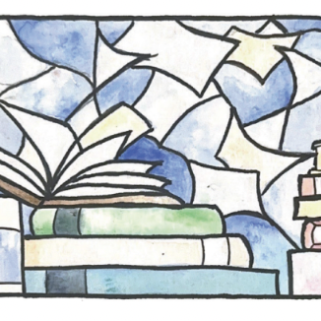A group of thirteen students has gathered at an airport in Toulouse, France. We are en route to a small village called Auvillar for a month-long intensive studio art summer program led by the painter and Yale School of Art Professor Robert Reed ART ’62. At 75, Reed is smaller and frailer than I had imagined, but he’s beaming. Most of us are meeting him for the first time, but he already knows our names. He speaks in a tender tone, as if catching up with a good friend he hasn’t seen in years, and listens attentively. It is early June of 2014, and the southern French countryside that flies by the bus from Toulouse to Auvillar fulfills every painterly cliché of itself—beautiful light, fragrant air, old stone houses dotting the river banks.
But there is little time to enjoy the scenery. Under the guidance of Reed and his four teaching fellows, we spend nearly all of the next four weeks drawing and painting our “investigations”—Reed’s term for the subjects we have chosen to concentrate on for the course of the program. We begin with life drawings from objects we find ourselves. A pile of bricks, a miniature forest of moss, twigs, and pebbles, and a whole artichoke all find their way into the studio. The commitment is total; the work is personal and at times discomforting. Laptops, cell phones, headphones, and visitors are absolutely banned. On the third night, after two days of misguided attempts and Reed’s disapproval, I had panicked, having realized it wouldn’t be a leisurely summer session of plein air painting. To stop myself from running away, I dragged my empty suitcase to the studio and started drawing it.
The works we create range from palm-sized to wall-sized, from six pieces to over a hundred per student for each day’s review session, which Reed calls an “observation.” “Quantity is the direct result of the intensity of your search,” he often reminds us. The studio is in a constant flurry of pieces of paper and cardboard that we fill with charcoal and graphite in a matter of minutes. The physical motions we use to produce drawings become muscle memory.
Titled “Studio Practice in Painting and Drawing,” Reed’s course in Auvillar was the final installment in a series of programs he created throughout his life. The program exemplified his pedagogy: an isolated setting, unique vocabulary, and a dedicated group of students ready to form a tight-knit community. In 1960, as a student at the Yale School of Art, Reed participated in the Yale Summer School of Music and Art in Norfolk, then taught by the famed artist Philip Guston. According to Reed’s wife, Susan Whetstone, the Norfolk experience was among his most formative. “Robert produced a lot of work as a painter, but he hoped his legacy would be primarily as a teacher. The programs [he designed] came out of his experience at Norfolk, which was very interdisciplinary, with musicians, painters, and other artists all working together. It was a total experience of being enmeshed in your work, your art, twenty-four-seven.”
“It sounds like some kind of a cult,” said David Whelan ART ’12, Reed’s teaching fellow in Auvillar in 2013 and 2014, remembering the program. “But the intensity encourages vulnerability so that participants find each other in that vulnerable moment, and depend upon each other throughout the experience.”
Late at night, tens of drawings into a demanding investigation, we pushed each other through fatigue, frustration, and moments of doubt. But as Reed kept reminding us, the program was a rare opportunity to sustain singular focus so intensely. He often used the analogy of a rubber band: the program’s mission was to help us stretch further than we ever thought we could be stretched. By the end of the program, each one of us made over four hundred pieces of work.
“I will go down in history as the person who took the most seminars with Robert,” Mary Scarvalone told me, laughing. Scarvalone, a Cap d’Antibes-based artist, participated at least once in every one of Reed’s programs after she met him in 1975. The personal and artistic growth spurts that happened in the programs kept her coming back. “Bob gave you the knowledge that you don’t have to be easy on yourself and do the bare minimum. You go through the process of continually working an idea, and working and working it, doing the fifty drawings. As you do them, you discover new things you hadn’t seen before,” she said. The last time Scarvalone worked with Reed was in 2012, in Auvillar. Recently, she and a sculptor friend locked themselves in her studio in Cap d’Antibes, a town on France’s Mediterranean coast, for a three-day weekend of nothing but drawing with the intensity she learned from Reed.
The summer of 2014 was the last year of Reed’s program in Auvillar. That fall, I took his “Introduction to Painting” class at Yale. It was the last time he taught that, too; he was hospitalized intermittently throughout the semester, but he came back immediately each time he was released. In December of that year, Reed passed away at the age of 76.
I had many professors after Reed, but I never, not even after graduating in May this year, stopped looking back at the experience of working with him. After knowing the energy that comes from intense focus and dedication to one’s work, anything less feels inadequate, dishonest. For the Yale Summer Session staff, finding someone confident enough to carry the torch and keep the Auvillar program running has proved impossible. Reed’s program was fiercely his own, a product of his own lifelong investigation. The following summer, the studio in Auvillar was empty of students. But across the country and the world, the rubber bands continued to stretch.


